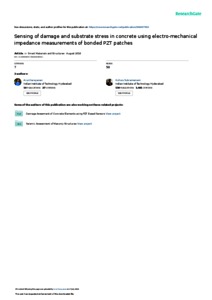Narayanan, Arun and K V L, Subramaniam
(2016)
Sensing of damage and substrate stress in concrete using electro-mechanical impedance measurements of bonded PZT patches.
Smart Materials and Structures, 25 (9).
095011-1.
ISSN 0964-1726
![[img]](http://raiithold.iith.ac.in/2647/1.hassmallThumbnailVersion/Smart%20Materials%20and%20Structures_25_9_1-16_2016.pdf)  Preview |
|
Text
Smart Materials and Structures_25_9_1-16_2016.pdf
- Accepted Version
Download (9MB)
| Preview
|
Abstract
The influence of stress and induced damage in concrete on the electro-mechanical (EM) impedance response of bonded PZT patches is evaluated for applied compressive loading. Full field displacements obtained from digital image correlation are used to evaluate the level of stress-induced damage in concrete. Stress in the substrate produces an imposed strain on the PZT. A change in the imposed strain produces a rightward frequency shift and an increase in the amplitude of the resonant peak in the EM conductance spectrum of the PZT. An increase in the substrate compliance produces a decrease in the resonant frequency and an increase in the amplitude of the resonant peak. Changes in the resonant peak in the conductance spectrum induced by increasing substrate stress are of a significant magnitude when compared with the changes induced by damage. In the early stages of damage associated with distributed microcracking, the counteracting influences of increasing level of damage and increasing stress on the resonant peak result in no shift in frequency for measurements under applied load. There is however an increase in the amplitude of the resonance peak. When the applied stress is removed, there is a net decrease in frequency resulting from damage in the form of distributed microcracks. Measures of changes in the resonant peak based on root mean square deviation (RMSD), do not show any observable change when measurements are performed under applied loading. There is a consistent increase in RMSD values and frequency shift with increasing damage when the applied stress is removed. The centroidal measure of the normalized frequency spectrum reflects changes in substrate stress. At higher applied stress levels, there is a nonlinear increase in damage, leading to localization and cracking. The influence of damage is dominant in this region and significant changes are obtained in the RMSD values in both loaded and unloaded conditions.
Actions (login required)
 |
View Item |


 Altmetric
Altmetric Altmetric
Altmetric